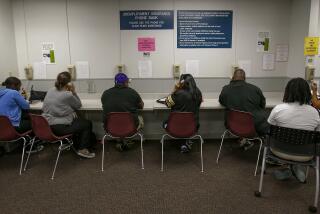U.S. Jobless Rate Remains at 6.9% for a 3rd Month : Manufacturing, Services Again Post Gains; Stateâs Unemployment Inches Up
WASHINGTON â The nationâs unemployment rate remained at 6.9% in November for the third consecutive month even though one survey indicated that 249,000 jobs had been created during the period, the government reported Friday.
The 249,000 figure is based on a survey of jobs created by more than 250,000 business establishments and is considered significant by many economists. The November figure was an increase of 10,000 over October, when 239,000 jobs were created, according to the survey.
In its monthly unemployment report, the Labor Department does a parallel survey of 59,500 households across the nation. That survey reported only 133,000 new jobs.
A separate Labor Department measure of unemployment, which excludes members of the armed forces residing in the United States, put the November jobless rate for civilians at 7% for the third month in a row. In California, the civilian unemployment rate was 6.8%, up from 6.6% in October and 6.4% in September.
Of the reported new jobs, more than 200,000 were in services industries, continuing a pattern established in the past few years of an economy with a booming services sector but a manufacturing sector battered by foreign imports into virtual recession.
However, in November, for the second month in a row, there was a small increase in employment in manufacturing industries, about 35,000 jobs, after an increase of 23,000 in the month before.
Reverses Slide in Manufacturing Jobs
The small increase took place after many months of steady declines in manufacturing employment, and some economists saw this as another sign that the nationâs trade deficit may be turning around.
âThe manufacturing news is as good as it has been in a long while,â said Christopher Caton of Data Resources Inc. âWith the better trade figures in September and October, it looks like a genuine two-month uptick. It may mean that the trade deficit will finally be pulled off the back of the manufacturing sector.â
But, he cautioned, while some light may begin to glimmer at the end of the tunnel, âitâs still a rough track from here to there.â He pointed out that goods-producing industries will have to absorb a cutback in car production while inventories are allowed to dwindle, and probable layoffs might worsen the unemployment picture in the next few months.
Indeed, Jerry J. Jasinowski, the National Assn. of Manufacturersâ chief economist, whose views of the economic near future are often bleak, saw less good news ahead.
âWe are not going to see any improvement in unemployment levels until the manufacturing sector shows stronger growth,â he said in a statement. âAt this stage, I expect unemployment to rise in the first months of 1987, because we are not going to see a major recovery in manufacturing employment and because services employment growth will slow.â
Most Categories Unchanged
The unemployment statistics for various population segments were virtually unchanged during the month, except for a sizable decline in unemployment among Latinos to 9.5% from 10.5%. The other categories: whites, 6.1%, up from 6% in October; blacks, 14.3%, down from 14.4.%; adult men, 6.2%, unchanged; adult women, 6.1%, unchanged; teen-agers, 18.4%, up from 17.6%; black teen-agers, 35.1%, up from 34.8%.
Meanwhile, officials told the Associated Press on Friday that the Reagan Administration is lowering its forecast for economic growth in the coming year as work continues on a proposed $1.02-trillion budget for fiscal 1988. Instead of the 4.2% growth the Administration had predicted, top-level government economists have projected growth at 3.5% for the coming year, the Administration sources said.
However, the three officers who must sign off on the economic figures to be used in the budget--Treasury Secretary James A. Baker III, Budget Director James Miller and Beryl Sprinkel, chairman of the Council of Economic Advisers--reportedly have not reached agreement on this figure.
Separately, the Federal Reserve Board reported Friday that Americans, still borrowing heavily to finance new car purchases, took out $6.78 billion more in consumer debt than they paid off in October. The Fed said the October increase followed an even larger $7.72-billion September advance, with both months reflecting heavy borrowing to purchase new cars.
More to Read
Inside the business of entertainment
The Wide Shot brings you news, analysis and insights on everything from streaming wars to production â and what it all means for the future.
You may occasionally receive promotional content from the Los Angeles Times.










